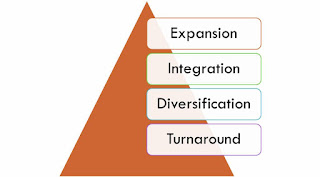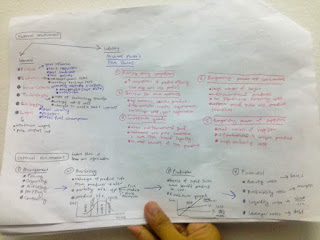- Political factors
- Economic factors
- Socio-cultural factors
- Technological factors
- Ecological factors
- Legal factors
Monday, 25 December 2017
PESTEL FACTORS
What is PESTEL? It is an analysis is a framework or tool used by marketers to analyse and monitor the macro-environmental (external marketing environment) factors that have an impact on an organisation. The result of which is used to identify threats and weaknesses which is used in a SWOT analysis. It is a shortform of
BREAKEVEN GRAPH
In the internal factor analysis, there are 4 functions that is used to be monitor to build strategies. it is management, marketing, production and financial. In the production factor, there is a thing must be observed. It is breakeven graph. We must ensure that we are reaching the breakeven point. breakeven point is total cost and total revenue are equal. There is no net loss or gain, and one has "broken even," though opportunity costs have been paid and capital has received the risk-adjusted, expected return.
PRODUCT LIFE CYCLE
In the internal factor analysis, there are 4 functions that is used to be monitor to build strategies. it is management, marketing, production and financial.In the marketing factor, there is a thing must be observed. It is called Product Life Cycle. The product life cycle is an important concept in marketing. It describes the stages a product goes through from when it was first thought of until it finally is removed from the market. Not all products reach this final stage.
We build strategies suitable according to each stage and phase.
MARKETING MIX
The marketing mix is a foundation model in marketing. The marketing mix has been defined as the "set of marketing tools that the firm uses to pursue its marketing objectives in the target. Marketing mix is the tactical or operational part of a marketing plan. The marketing mix is also called the 4Ps. It is:,
How they use this 4Ps to build strategies?
Secondary Level Strategies
In the corperate level strategies, there are divided into 3 stages, which are Grand Strategies, Secondary Level Strategies and Tactical Level Strategies. Corporate level strategies related to top management level, for the benefit of the whole organization, for the welfare of corporations in future and to bring it at higher position.
In Secondary Level Strategies, there are 4 subdivided:
In Secondary Level Strategies, there are 4 subdivided:
- EXPANSION- increase existing activies. ( Giant, Tesco, KFC)
- INTEGRATION - Control operations. it is divided into vertical and orizontal strategy. Vertical includes backward and forward integration strategies.
- DIVERSIFICATION - increase output. It has Concentric, Conglomerate, Horizontal and Geographical diversification strategies.
- TURNAROUND - actions to face some difficulties.
GRAND STRATEGIES
In the corperate level strategies, there are divided into 3 stages, which are Grand Strategies, Secondary Level Strategies and Tactical Level Strategies. Corporate level strategies related to top management level, for the benefit of the whole organization, for the welfare of corporations in future and to bring it at higher position.
This post is going to share with you about Grand Strategies. Grand Strategies is divided by 4:
- Growth Strategy
To ensure next
year’s growth rate is higher than the previous
year
- Stable Growth Strategy
To target a growth rate similar
to that as achieved in the previous year
- Turnaround Strategy
A choice when the company has
been experiencing a bad spell and
at a certain time decides that it needs to do a turnaround
- Combination Strategy
some of the components will have to
go down in order for its other components to go up.
EXTERNAL & INTERNAL ENVIRONMENTAL ANALYSIS
EXTERNAL & INTERNAL ENVIRONMENTAL ANALYSIS provides information to managers regarding the key trends and changes in the external and external environment. Here I prepare a note/summary on external and internal factor analysis chapter.
Strategic Factors Analysis Summary (SFAS)
In SWOT Analysis, there is a medium called Strategic Factors Analysis Summary (SFAS) used to summarizes a corporation’s strategic factors by combining the external factors from the External Factors Analysis Summary (EFAS) Table with the internal factors from the Internal Factors Analysis Summary (IFAS) Table. The SFAS Matrix requires the strategic decision maker to condense these strengths, weaknesses, opportunities, and threats into ten or fewer strategic factors. This is done by reviewing each of the weights for the individual factors in the EFAS and IFAS Tables. The highest weighted EFAS and IFAS factors should appear in the SFAS Matrix (Hunger & Wheelen, 2010, pp. 74). This is the elements of a Strategic Factors Analysis Summary:
LEVEL OF STRATEGIES
Thompson (1997) states that the definition of strategic management involves the issue of how strong and successful an organization's strategy is and how the change is made. For Pearce & Robinson (1997), strategic management is defined as a set of decision-making and actions that results in the formulation and implementation of plans designed to achieve organizational objectives. For David (1997), strategic management can be defined as art and science in formulating, implementing and evaluating decisions for overlapping functions to enable an organization to achieve its objectives. While Bourgeois et al. (1999) states that strategic management is an important activity for management who responds to what is happening in the organization. While Edaris (2004) states that strategic management can generally be regarded as 'brain' while strategic planning is 'backbone' to management.
There are 3 level of strategies, which are :
It is different from each other according their own aspects related to factors, actions and strategies.
Monday, 23 October 2017
What is SWOT Analysis?
SWOT Analysis is a useful technique for understanding your
Strengths and Weaknesses, and for identifying both the Opportunities open to
you and the Threats you face. Used in a business context, it helps you carve a
sustainable niche in your market. We also can use it to measure our own
self performance.
So, this image will show
you more clearly figure about the structure of SWOT Analysis method:
Self SWOT Analysis
Strengths:
- Quick idea
- Meticulous in doing
typing works
Weaknesses:
- Easy to get stress
- Not able to focus doing
two things in one time
- Not good in dealing with
higher position people
Opportunities:
- Business field job
opportunities
- Islamic
perspective/sector knowledge job opportunities
- Arabic language career
Threats:
- Compete with other
graduates
- Compete with other
experienced employeeployee
Subscribe to:
Comments (Atom)









